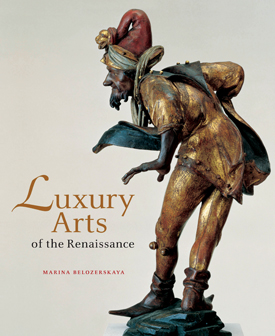
Luxury Arts of the Renaissance
Marina Belozerskaya
2005
288 pages
PDF file size: 47.0 MB
Description
Today we associate the Renaissance with painting, sculpture, and architecture—the “major” arts. Yet contemporaries often held the “minor” arts—gem-studded goldwork, richly embellished armor, splendid tapestries and embroideries, music, and ephemeral multi-media spectacles—in much higher esteem. Isabella d’Este, Marchesa of Mantua, was typical of the Italian nobility: she bequeathed to her children precious stone vases mounted in gold, engraved gems, ivories, and antique bronzes and marbles; her favorite ladies-in-waiting, by contrast, received mere paintings. Renaissance patrons and observers extolled finely wrought luxury artifacts for their exquisite craftsmanship and the symbolic capital of their components; paintings and sculptures in modest materials, although discussed by some literati, were of lesser consequence.
This book endeavors to return to the mainstream material long marginalized as a result of historical and ideological biases of the intervening centuries. The author analyzes how luxury arts went from being lofty markers of ascendancy and discernment in the Renaissance to being dismissed as “decorative” or “minor” arts—extravagant trinkets of the rich unworthy of the status of Art. Then, by re-examining the objects themselves and their uses in their day, she shows how sumptuous creations constructed the world and taste of Renaissance women and men.
Table of Contents
- Abbreviations
- Acknowledgments
- Prologue
-
I: The Demise of Luxury Arts
- Rank, not Genius
- Art Academy as Social Strategy
- Vasari’s Imaginary Lives
- “Art and Nature Play with One Another”
- The Eighteenth Century: A Turning Point or Continuity?
- The Age of Public Museums in Art Education
- Back to the “Period Eye”
-
II: The Powers of Gold and Precious Stones
- The Spiritual Aura of Gold and Gems
- The Magical Powers of Metals and Gems
- Geography and Learning
- Goldwork and Diplomacy
- Gold, Automata, and the Culture of Wonder
- The Royal Table
- The Language of Personal Adornment
-
III: Woven Narrative of Rule
- Princely Art par Excellence
- The Language of Allegories
- Tapestries as Gifts and Competition
- Tapestries for Social Climbing
- Making and Marketing
-
IV: Armor: The High Art of War
- The Ubiquity of War, the Practicality of Armor
- Chivalric Displays
- Parade Armor: The Theater of Supremacy
- Garnitures
- Leading Armorers of the Day
- Production and Techniques
- Decorations
-
V: Sweet Voices and Fanfares
- Sacred Polyphony
- Secular Songs
- Instrumental Music
- Dance
- Court Festivities and Music
-
VI: The Seduction of All Senses
- The Wedding of the Century
- The Ephemeral War
- Civic Pride and Private Ostentation
- The Final Journey and Perpetual Memory
- Notes
- Bibliography
- Index
About the Authors
Marina Belozerskaya received her Ph.D. from the University of Chicago. She is the author of several articles and books, including Rethinking the Renaissance: Burgundian Arts across Europe (Cambridge University Press, 2002) and Ancient Greece: Art, Architecture, and History, with Kenneth Lapatin (J. Paul Getty Museum, 2004).